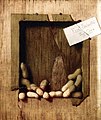De Scott Evans
De Scott Evans (actually: David Scott Evans ; born March 28, 1847 in Boston , † July 4, 1898 in the Atlantic Ocean on a trip from New York to Paris) was an American painter who worked primarily as a genre and portrait painter was active. He received special attention in the late 20th century due to the attribution of numerous pictures in the American trompe l'œil style, which he is said to have painted under several pseudonyms .
Life
David Scott Evans was born in 1847, the fifth of six children to country doctor David Souder Evans and his wife Nancy Evans (née Davenport). He received his first official artistic training in 1864 in the studio of the painter Albert Beaugureau in Cincinnati . In the early years of his professional career, Evans worked as a teacher, in 1872 he married Alice Josephine Burke of Ohio, with whom he later had two daughters, Mabel and Blanche. The couple also adopted a third daughter, Laura. In the same year he was employed as a teacher of arts and music at Smithson College in Logansport , Indiana, and from 1873 to 1875 he directed the fine arts department at Mt. Union College in Alliance , Ohio.
In 1874 Evans moved with his family to Cleveland , Ohio, and founded a studio there in order to devote more time to painting. He worked under his stage name De Scott Evans, which he had first used in Alliance and became the first teacher of the later Impressionist Otto Bacher . His own training led Evans to Paris in 1877 , where he studied with the academic painter William Adolphe Bouguereau . After this training he established himself as a portrait painter and was a founding member of the Cleveland Academy of Art in 1882 .
Evans had been exhibiting at the National Academy of Design since 1881, and in 1887 he moved to New York City and joined the Salamagundi Club , which was highly regarded at the time. In 1898 he traveled again to Paris to take on an order, but did not reach his destination, as the French passenger steamer La Bourgogne was rammed by another ship on the crossing on July 4th and went down; De Scott Evans drowned with his three daughters. His wife Alice was not on board.
plant
The work of De Scott Evans is described as average for a painter of his time, who were marked by the American Civil War reached the height of their work immediately after it and achieved modest fame as genre and portrait painters. As a result, the work of many of these artists was quickly forgotten, and most of Evans' works were hardly noticed after his death. One exception is the painting Winter Evening at Lawnfield , which depicts a portrait of the family of President James A. Garfield and was commissioned by his widow shortly after his death in 1881. This contract is considered Evans' greatest achievement in Cleveland.
In general, De Scott Evans painted portraits of young women and he was best known for his costumes. Inspired by a number of artists of his time such as Winslow Homer , William Merritt Chase and Eastman Johnson , Evans used a number of different styles for his paintings.
Attribution of numerous trompe l'oeil works
By the two American art historians William Gerdts and Russel Burke , De Scott Evans was assigned a series of works in the American trompe l'œil style for the first time in 1971 , which he is said to have painted under various pseudonyms. They justified the assignment by discovering two almost identical paintings on which pears are depicted hanging on a string, one of which was signed "De Scott Evans", the other with "Scott David". Further discoveries such as pairs of pictures with hanging apples, signed with “Stanley David” and “Scott David”, as well as an ax hanging on a wall, signed with “D. Scott Evans ”and“ Stanley S. Evans ”provided further evidence. In addition, there are several pictures with almonds or nuts behind a recess in the wall, which are signed as“ SS David ”and“ Stanley S. David ”respectively. Evans is believed to have made these cover-ups because trompe-l'oeil artists such as William Michael Harnett , John Haberle, and John Frederick Peto had little reputation and thus wanted to protect his established name.
The assignments are now generally accepted, although there are also indications that speak against this theory. The trompe-l'œil group of works now comprises a total of around 50 paintings with six variants of the David signature. Evans Vita has no clues for trompe l'œil activities and the pictures show quite different stylistic characteristics, which also allow the assumption that there may have been several artists. The most serious evidence against Evans' authorship is a painting called Washington's Hatchet with the name Stanley David stamped on the original stretcher - so it is entirely possible that there actually was a Stanley S. David, but one of that no signs of life are known.
literature
- Stephan Koja: America. The New World in 19th Century Pictures. Prestel-Verlag 1999; Pp. 180-181 and pp. 252-253. ISBN 3-7913-2051-3
Web links
| personal data | |
|---|---|
| SURNAME | Evans, De Scott |
| ALTERNATIVE NAMES | Scott Evans, David (real name); Scott, David (pen name); Stanley, David (pseudonym); Evans, D. Scott (pen name); Evans, Stanley S. (pseudonym); David, SS (pseudonym); David, Stanley S. (pseudonym) |
| BRIEF DESCRIPTION | American painter |
| DATE OF BIRTH | March 28, 1847 |
| PLACE OF BIRTH | Boston |
| DATE OF DEATH | 4th July 1898 |
| Place of death | Atlantic Ocean |









